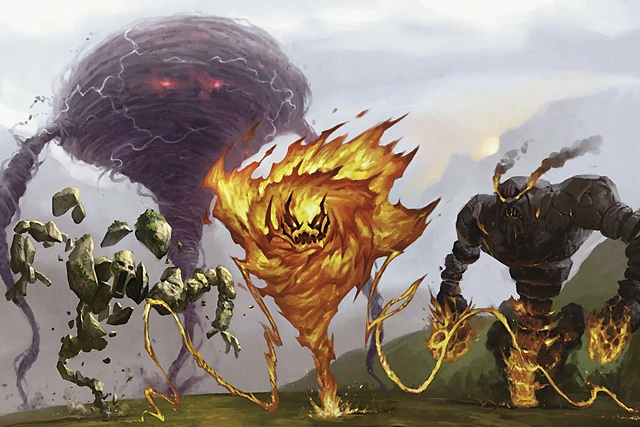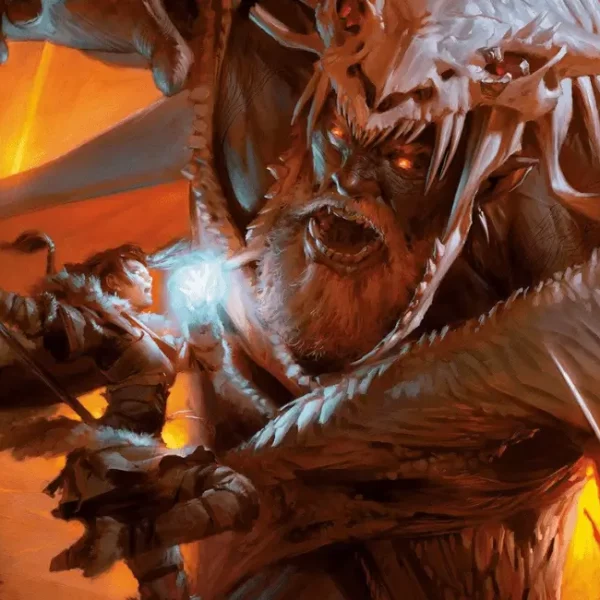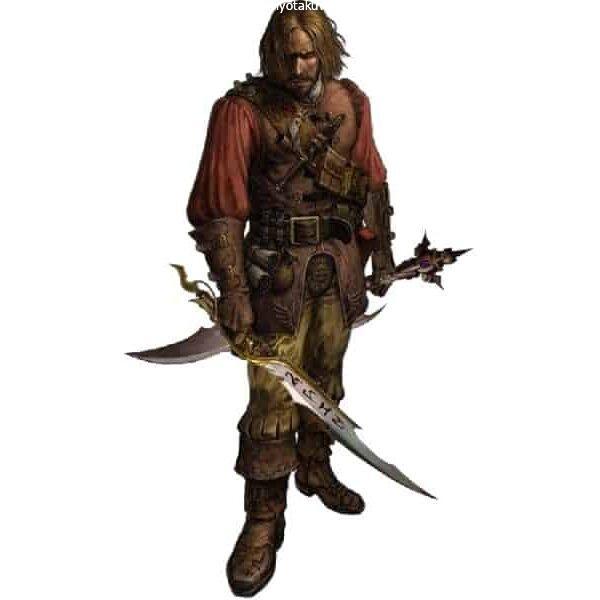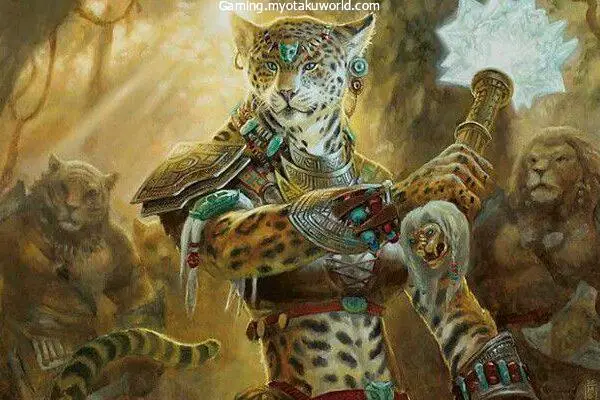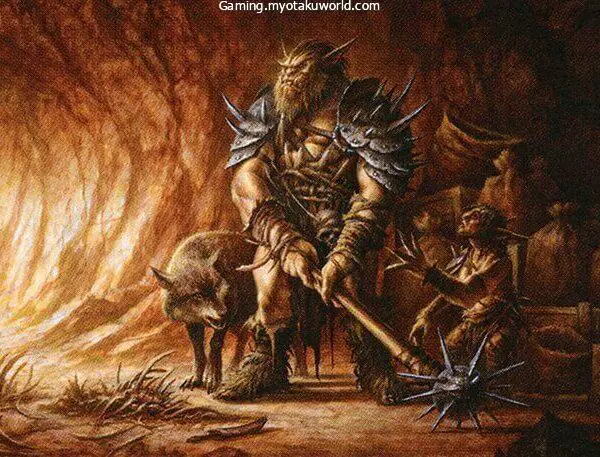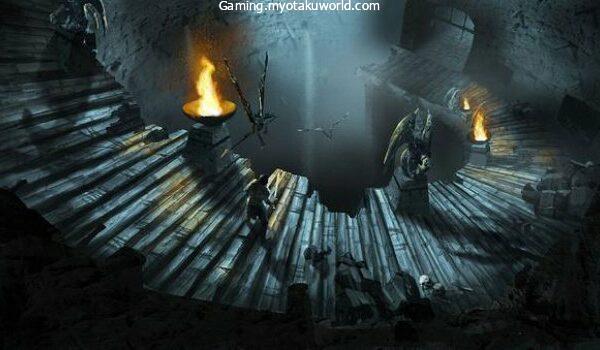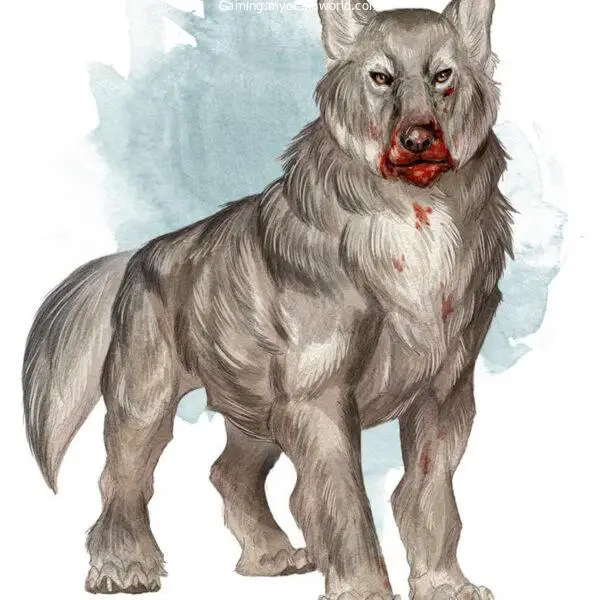The raging fire blew back and forth and jumped around.
From the fire, a shape appeared.
It didn’t look like a person, but it came out of the flames and turned towards the adventurers.
In Dungeons & Dragons and other RPGs, elemental creature typeare pretty common.
But what exactly are elementals in 5e?
How many kinds are there?
And from where do they come?
We’ll talk about everything you need to know about D&D 5e elementals.
How to use them in your game and the different kinds.
So, let’s start with what D&D 5e elementals are.
Elementals in D&D 5e
In D&D 5e, an Elemental is a type of creature.
It is made up of different monsters that are connected to the “elements” of nature, such as fire, water, etc.
These monsters look like parts of nature, or “avatars,” but they are not real.
In D&D 5e, elemental creatures are natural forces that can move around.
Elementals come in two very broad and basic types: natural things that come to “life” because of magical forces, and living things that get their power from an element.
On page 6 of the Monster Manual, it says the following about elementals:
Elementals are creatures native to the elemental planes. Some creatures of this type are little more than animate masses of their respective elements, including the creatures simply called elementals. Others have biological forms infused with elemental energy. The races of genies, including djinne and efreete, form the most important civilizations on the elemental planes. Other elemental creatures include azers, invisible stalkers, and water weirds.
Even though they look and act differently, elementals in 5e have a few things in common.
The true elementals, which are monsters with names like “Air Elemental,” “Fire Elemental,” etc., can’t be hurt by bludgeoning, piercing, or slashing damage from weapons that aren’t magical.
There are times when they have more resistance.
So, if you want to fight these creatures well, you’ll need a magical weapon.
Also, except Earth Elementals, all of the other true elementals have a damage immunity tied to their aspect.
For example, fire attacks don’t hurt Fire Elementals (duh).
And Poison damage doesn’t hurt any true elemental.
Technically speaking, they aren’t “alive,” so it’s almost like fighting creatures that were made by humans.
But, different, I guess.
Another thing that all true elementals have in common is that they all have a unique way of moving that goes with their affinity.
Air can fly way too fast, Earth can burrow, Fire moves faster on the ground in general, and Water can swim way too fast.
So, fighting each true elemental creature in its natural environment makes it more dangerous.
For fire, that means pretty much anywhere on the ground that doesn’t have water.
In 5e, genasi are made up of elements as well.
Since genasi are half-elementals, they of course have strong ties to the elemental creature type.
Finally, elemental creatures in D&D 5e share a common language in Primordial.
But this then breaks down into four sub-languages: Auran for air elementals, Terran for earth elementals, Ignan for fire elementals, and Aquan for water elementals.
So, elementals might understand and speak Primordial as their main language, but they might only know one of the categories of this language.
Aside from these similarities, elemental creatures vary wildly from each other given their affinity for a very specific aspect of nature.
Since these creatures represent the world’s natural forces, they look and act in a lot of different ways.
Yes, they all got their ideas from the same place: giving the world’s natural forces shape, freedom, and sometimes intelligence.
But each kind of elemental has its basic traits and characteristics.
Types of Elementals in 5e
Air elementals, earth elementals, fire elementals, and water elementals are the four basic types of elemental creatures in 5e.
Now, these elementals can cross over with each other.
For example, Mephits are all made up of elements that are next to each other.
But most of the time, elementals don’t get too close to each other.
In D&D 5e, the main types of elements are:
- Air Elementals
- Earth Elementals
- Fire Elementals
- Water Elementals
Air Elementals
Air elementals show how the wind and sky are free and always moving.
Most of the time, these elementals have abilities that make them hard to catch, like being immune to the Grappled condition.
Because they are so connected to the wind, sky, and air itself, they can also fly often.
Other creatures with the Air element are also able to fly and avoid being caught.
Air monsters can kill their prey by literally sucking the air out of them.
This is a particularly nasty way to kill.
Earth Elementals
The strength, rigidity, and toughness of stones, gems, and natural metals are shown by earth elementals.
Among the elementals, earth elementals often have the best Strength Ability Scores.
Because of how they look, they are also usually the most physically capable, preferring to use physical attacks over more magical or ephemeral ones.
Most of the time, it’s hard to get rid of creatures that are made of earth.
Most of the time, they have a good Armor Class and a lot of hit points.
Not only that, but they hit like a truck, making melee combat with them very dangerous and very quickly.
Fire Elementals
The wild and destructive nature of fire is shown by fire elementals.
Since they are the fastest true elementals on the ground, they hit hard and fast.
As a fun extra, when Fire Elementals attack, they can set their enemies on fire.
Fire Elementals set their prey on fire and let them burn while Earth Elementals beat them up.
Many of the fire elementals also do more fire damage when they attack.
This makes perfect sense, but it stands out because most of the other elementals don’t get a damage boost that matches their aspect.
Most of the time, water elementals don’t deal cold damage, and earth and air elementals don’t have a damage type that goes well with them.
Air elementals could deal thunder damage, I guess.
But most of the damage they do is through blunt force.
Water Elementals
Water elementals represent how water can be shaped and changed.
True Water Elementals are especially dangerous because their main and most recognisable ability is to pull creatures into their liquid form and drown them.
They are attacked in the usual ways.
But the real plan is to move into the space of a creature to try to pull it into the body of a Water Elemental.
And, for the most part, this plan still works.
Some Water elementals are hard to catch because they blend in perfectly with a body of water, as long as they can completely submerge themselves.
This makes them dangerous enemies that can wait for your players and catch them off guard.
Where Elementals Come From?

The forces of nature are represented by elements.
So, they usually come from places where the energy of the elements is very strong.
Now, according to the rules as they are written, elementals live on one of the Elemental Planes.
These planes are places of pure elemental energy that are clear and dramatic.
I like this idea, but I think saying that elementals can only come from these places is a bit too limiting.
So, I would like to add that if there is enough natural energy or magic, elementals could be born in the real world, or other creatures could absorb parts of an element there.
This means that elementals could come from either the Elemental Plane or the real world.
Because there are four different parts to the Elemental Planes.
Let’s break each of these down.
Let’s start with the Elemental Plane, which is the more obvious of the two.
The Elemental Planes
According to the basics of D&D, the Elemental Plane surrounds the material realm.
Then, this Plane divides into four smaller planes, which you can probably guess, i.e. Air, Earth, Fire, and Water.
Each plane is a physical manifestation of the element it is made of.
Elemental Plans are basically what you get if you take the idea of one of the four elements and turn it into a place you can go.
Now, depending on who is running the game, different things can be done with these sub-plans.
I’ll talk about that as we talk about each Elemental Plane.
Each Plane is also next to two others, where the two elements come together strangely.
Also, each Plane of Elements is different from the others.
On the map of the universe, these planes are right next to each other, but they don’t normally interact with each other.
As I said, all of this is basic D&D.
And you can change, add, or take away anything you want in TTRPGs to make it fit your story.
This just gives you a good place to start.
Let’s talk about the different planes of elements.
Elemental Plane of Air
In D&D 5e, the Air elementals live on the Elemental Plane of Air.
It has wide-open skies, warm breezes, and violent storms.
As often as the clouds move and change, so does this realm.
One minute, you’re blown along by a light breeze, and the next, you’re caught in a dark, violent storm.
Now, one of the most common ideas about the Plane of Air is that it doesn’t touch the ground.
Sometimes you’ll see clouds that are thick enough to stand on or stray bits of earth floating around.
But this Plane is often just a sky that goes on forever in every direction.
The Elemental Plane of Air is on the other side of the Plane of Earth from the Planes of Fire and Water.
Elemental Plane of Earth
The stone-based elementals live on the Elemental Plane of Earth.
This plane is made of solid stone, gems, and metals that come from the earth.
It’s a hard plane, just like the stone.
Like the other planes, the Plane of Earth can be seen in different ways.
Most of the time, it either has nothing on top of the ground but still has a topside or is a solid plane of the earth with no sky.
People who live on the Plane of Earth either eat other living things or gems or rocks.
The Plane of Air is on the other side of the planes of fire and water from the plane of earth.
Elemental Plane of Fire
The Elemental Plane of Fire is a place where flames and heat are very strong.
The Plane of Fire is either a huge hot desert or a great never-ending, raging fire.
It is thought to be the harshest of the Elemental Planes.
Creatures that can’t take fire damage or aren’t immune to it often have a hard time even getting to the Elemental Plane of Fire.
The Plane of Water is on the other side of the Planes of Air and Earth from the Plane of Fire.
Elemental Plane of Water
No matter how you look at it, the Elemental Plane of Water is a big ocean.
Now, people have different ideas about whether this huge body of water is on top of the plane or if the whole plane is filled with water.
If the Plane of Water has a top, you might find some small islands with races that don’t live in water.
But most of the time, you’ll find animals that live in water and can stay alive there.
The Plane of Water is on the other side of the Plane of Fire from the Planes of Air and Earth.
The Material World
Now, the easiest answer to the question “Where do elementals come from?” is the Elemental Planes.
However, they could also just appear in the real world.
In D&D 5e, places with a lot of elemental power, like a scorched desert or a big mountain, are great places for elemental creatures to be born.
Maybe they are at a magical crossroads where ley lines meet and give the elements shape.
Or, maybe a group of druids combined their magic to create a zenith of natural energy where elementals form.
Another choice combines the idea that elementals can form in the real world and the magic of the Elemental Planes.
If the border between the Material Plane and the Elemental Plane is thin in one place, the natural energy of the Elemental Plane might leak through and create elementals.
In all honesty, there are a lot of options.
How you want elementals to form in your world depends on your world and your imagination.
Using Elementals in Your Game
Elementals are great random encounters for quests that take place in certain biomes.
But because they stand for nature’s most basic forces, they also make great focal points for whole campaigns.
Many elementals lack personal ambition.
They only show their appearance and don’t care much about other creatures or beings.
Because of this single-mindedness or lack of awareness, some of the more basic elementals in D&D 5e are a lot like beasts.
They know they’re there, and that’s enough for them.
Even if they don’t want to do anything, elementals can be pretty interesting and unique encounters for your players.
Even though they aren’t very smart, elementals can usually understand some words.
Most game settings use a language that is pretty hard to understand.
But it is possible to talk to an elemental and maybe convince it to leave a place.
Elementals are still creatures, so you can still interact with them unless a spell says it won’t affect them.
You can always fight them, though.
Fighting the living wind is a pretty cool story to tell later.
Even so, the more powerful elementals could still be a long-term and constant threat just by being in the real world.
The Leviathan from Mordenkainen’s Tome of Foes could be the “bad guy” at the end of your game just because it’s so big and strong.
Because of how powerfully destructive this great elemental is, cults could form around it.
Maybe when it attacks, the creature rips holes in the Water Elemental Plane, letting Water elementals rush through the scars it leaves.
Being a literal force of nature, an elemental that is strong enough is a major threat to the world.
Even so, some elements have personalities and goals that others don’t have.
For example, compared to the True elementals, all of the genies in D&D 5e are smarter.
They are much more than just a chance to meet in a desert or a mountain.
These creatures might want to be part of something bigger.
And sometimes, something worse.
On the Elemental Plane of Fire, where Fire Elementals, Salamanders, and even Fire Giants live, an Efreeti, which is like a fire genie, might gather an army of them.
They want to set the physical world on fire so they can be known as a great conqueror.
Some of the more intelligent elemental creatures could be great and memorable bad guys.
D&D Elementals List

In D&D 5e, there are a lot of creatures that are made of different elements.
Here is a list of the elementals from DnD Beyond’s monsters page, with their CRs next to them.
There are a lot more animals that are made of elements.
0But you’ll need the different sourcebooks to get to all of them.
Without further ado, here is a list of D&D elementals by Challenge Rating (CR):
- CR 1/4
- Steam Mephit
- CR 1/2
- Dust Mephit
- Ice Mephit
- Magma Mephit
- Magmin
- CR 2
- Azer
- Gargoyle
- CR 5
- Air Elemental
- Dust Devil
- Earth Elemental
- Fire Elemental
- Salamander
- Water Elemental
- Xorn
- CR 6
- Invisible Stalker
- CR 11
- Djinni
- Efreeti
FAQs
Are Elementals Creatures in D&D 5e?
Yes, in D&D 5e, elements are the same as other creatures. The Monster Manual talks about them as a type of monster.
Can Elementals Speak?
Some 5e elementals can speak. For example, true elementals and djinn can talk. But some people, like the Water Weird, can understand but do not speak a language.
What Language Do Elementals Speak?
In D&D 5e, elementals speak Primordial or one of its four sublanguages: Auran, Terran, Ignan, and Aquan.
What is the Strongest Elemental in 5e?
How you measure “strength” in 5e determines which elemental is the strongest. You can use the Strength Ability Score or the Challenge Rating. Zaratan and Leviathan from Mordenkainen’s Tome of Foes have a Strength score of 30, which is their actual Strength Ability Score. Among elemental creatures, this gives them the highest Strength score. The Elder Tempest in Mordenkainen’s Tome of Foes and Maegera the Dawn Titan in Storm King’s Thunder both have a Challenge Rating of 23. This makes them the most powerful elemental monsters in terms of CR.
Summary
That’s all in 5e elementals.
One type of monster described in the Monster Manual is elemental.
They stand for the air, earth, fire, and water that make up the world.
And the Elemental Planes are where they live most of the time.
I’d like to point out that your game can have more than one type of elemental creature.
Even though these are the main four (with some wiggle room along the edges of the Elemental Planes), I find it a bit disappointing that there aren’t any other natural forces missing.
At least until we got some of the other books.
You might want lightning elementals or elementals that only work with metal.
Creatures that represent natural forces but are not one of the four basic types of elements.
